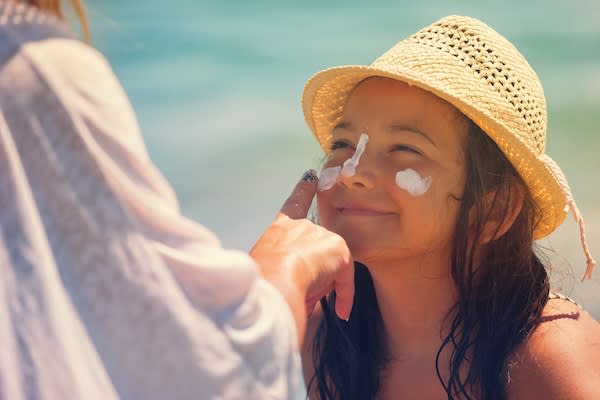
[6 MIN READ]
In this article:
-
Too much sun exposure can cause sunburn, skin cancer, premature aging, rashes, skin discoloration and sun spots.
-
Two of the best ways to protect yourself from the skin are to cover up your skin, and to stay inside or in the shade between the hours of 10 a.m. and 4 p.m.
-
If you notice you have a sunburn, the first thing you should do is get out of the sun right away.
How to stay safe in the sun: Your guide to UV protection
Anyone who has ever endured a vacation with lobster-red skin knows how important it is to protect yourself from the sun. But while a sunburn can be painful, the risk for skin cancer is an even worse consequence of too much sun and UV (ultraviolet) ray exposure.
During UV Safety Awareness Month this July, Providence is sharing some sun safety resources and information you can use to protect your skin — especially during the summer, when you’re outdoors and have the most exposed skin. The more you know about ways to protect your skin, the more you can limit your risk of skin cancer or benefit from less-invasive treatment options.
Why UV protection matters
First, let’s take a look at what UV rays actually are. Scientists use the electromagnetic (EM) spectrum to classify different types of EM energy, including microwaves, radio signals and X-rays, according to how energetic the photons are, and the size of the wavelength in each category. UV radiation is in the portion of the EM spectrum between X-rays and visible light.
“UV radiation from the sun is a major contributor to skin cancer,” says Trevan Fischer, M.D., a surgical oncologist at Providence Specialty Medical Group in Santa Monica, California. “This occurs mostly by the UV radiation directly causing damage to the DNA, which can lead to mutations allowing for uncontrolled cell growth.”
In addition to causing skin cancer and sunburn, sun exposure can also lead to:
- Skin discoloration
- Skin dryness
- Premature aging
- Rashes
- Dark spots and age spots
- Rough, leathery skin texture
Practical tips to stay safe in the sun
The best ways for you and your children to stay safe in the sun include the following:
- Avoid sun exposure during peak hours. According to the U.S. Environmental Protection Agency, the sun is strongest between 10 a.m. and 4 p.m. Whenever possible, limit your outside time to the early morning, late afternoon and evening.
- Wear protective clothing, hats and sunglasses. Your clothing shields you from the UV rays and is one of the most effective forms of sun protection.
- Apply sunscreen. It’s best to use sunscreen with an SPF of at least 30. Anything less than that puts you at risk for sunburn and skin cancer — especially if you have pale skin. Reapply sunscreen every two hours when you are out in the sun, and every half hour if you’re sweating.
Common myths about sun exposure
There are a number of myths circulating about whether certain types of sun exposure can be dangerous. Here are two of the most common ones:
Myth: You can’t get sunburned in the shade.
Fact: Even when you think you’re safe hanging out under a tree or umbrella, you’re still at risk for sunburn. The reflection of UV rays off the pavement or sand can burn your skin. According to the Skin Cancer Foundation, “the amount of UV present beneath an umbrella can be up to 84% of that in [the] sun depending on the levels of indirect UV.” Regardless of whether you plan on staying in the shade, remember to apply sunscreen.
Myth: You don’t need sunscreen on cloudy days.
Fact: Actually, up to 80% of UV radiation can still penetrate through clouds. That means if you skip the sunscreen, you are still putting yourself at risk for sunburn and skin cancer.
UV protection for different situations
It’s important to tailor your UV protection for different situations.
At the beach or pool
When you’re soaking in the rays near the water, be sure to:
- Wear sunscreen with SPF 30 or higher.
- When swimming, reapply the sunscreen every two hours.
- Use umbrellas, beach tents or natural shade to protect yourself.
- Consider sun-protective swimwear.
Everyday sun safety
Even when you’re not out at the beach or pool, you should still:
- Cover your exposed skin whenever possible with clothing and hats.
- Be extra cautious near snow, water and sand, because they can reflect UV rays.
- Choose sunglasses that block both UVA and UVB rays.
- Stay hydrated.
Protecting kids and babies
The best ways to protect your offspring include:
- Covering babies: If you’re taking a child younger than 6 months old outside, dress them in lightweight clothing that covers their skin, and keep them in the shade. Kids older than 6 months need head-to-toe coverage when they’re out in the sun.
- Helping your child apply sunscreen: You should also set a good example by using it yourself.
- Encouraging your kids to avoid sun exposure at school: You can urge them to wear sunglasses and wide-brimmed hats, and to put on sunscreen before recess.
What to do if you get a sunburn
If you or your children do wind up getting a sunburn, take these steps to relieve the pain and prevent yourselves from further harm:
- Get out of the sun right away. For as long as you have the sunburn, you should remain in the shade or completely covered when you’re in the sun.
- Take cool baths or showers, and use moisturizer or gel to soothe your skin.
- Drink extra water to avoid dehydration.
- If your skin blisters, allow the blisters to heal.
You should see your primary care provider or dermatologist if you experience the following symptoms:
- Blisters from your burn cover more than 20% of your body. You may need medication for inflammation.
- You have a high fever, chills or nausea. These could be signs of sun poisoning.
- Your skin shows signs of infection, such as swelling or pus. You may need to be prescribed antibiotics.
Your Providence provider can help determine whether you need additional care and show you how to get your skin checked for cancer.
Contributing caregiver

Trevan Fischer, M.D., is a surgical oncologist at Providence Specialty Medical Group in Santa Monica, California.
Find a doctor
If you are looking for a primary care provider or dermatologist, you can search for one who’s right for you in our provider directory. Through Providence ExpressCare Virtual, you can access a full range of health care services.
Download the Providence app
It’s all in the app: easily stay connected with Providence and your health. With the Providence app, you can schedule appointments, have virtual visits from the comfort of your own home, get health recommendations personalized for you, access your health records and so much more. Learn more and download the app.
Related resources
Five ways to prevent skin cancer
Don’t let psoriasis keep you from living life
How vitamin D supports the immune system
This information is not intended as a substitute for professional medical care. Always follow your health care professional’s instructions.
About the Author
More Content by Providence Cancer Team





















